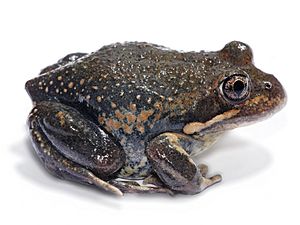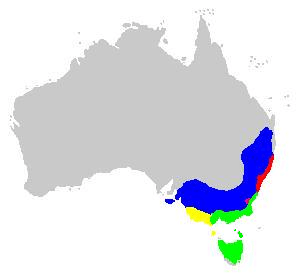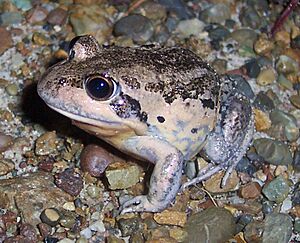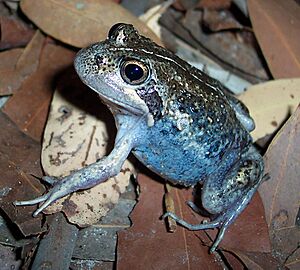Limnodynastes dumerilii facts for kids
Quick facts for kids Limnodynastes dumerilii |
|
|---|---|
 |
|
| Eastern banjo frog (Limnodynastes dumerilii dumerilii) | |
| Conservation status | |
| Scientific classification | |
| Subspecies | |
|
L. d. dumerilii |
|
 |
|
| Distribution of the Eastern Banjo Frog Limnodynastes dumerilii dumerilii in blue; Limnodynastes dumerilii grayi in red; Limnodynastes dumerilii insularis in green; Limnodynastes dumerilii fryi in pink and Limnodynastes dumerilii variegata in yellow. This is a general distribution map and it is possible for an overlap of about 5% of the range of sub-species adjacent to each other. |
The Eastern Banjo Frog (scientific name: Limnodynastes dumerilii) is a type of frog that lives in eastern Australia. People also call it the Southern Banjo Frog or Bull Frog. Its most famous name is Pobblebonk because of its special call. It sounds like a banjo string being plucked – a clear "bonk"!
There are five different kinds, or subspecies, of this frog. Each one has slightly different skin colors. These frogs are very common in their native home of eastern Australia. Once, in 1999, some tadpoles of this frog were found in New Zealand, but they were removed.
Contents
What Does the Banjo Frog Look Like?
Adult banjo frogs are usually about seven to eight centimeters long. That's about the length of a smartphone! They have dark, bumpy backs and a smooth belly that can be white or spotted. They also have a special gland on their lower leg and bumps on their feet.
Baby frogs, called tadpoles, stay in the water for a long time. They can take up to fifteen months to grow into adult frogs. There are five different types of Limnodynastes dumerilii, and they each have unique features.
Eastern Banjo Frog (Limnodynastes dumerilii dumerilii)
This is the most common type of banjo frog. You can find it in New South Wales, northern Victoria, and along the Murray River into South Australia. It likes to live in woodlands, heathlands, and farmlands.
These frogs breed in streams, ponds, and dams. The males of this type make the clearest "bonk" sound, just like a banjo. They often have orange on their sides and an orange stripe from their eye to their shoulder. Their back is usually one solid color.
Eastern Banjo Frog (Limnodynastes dumerilii grayi)
This type lives along the coast of New South Wales, down to Jervis Bay. It prefers coastal swamps, dams, and ponds near forests and heathlands. Unlike some other types, it does not breed in flowing water.
This subspecies often has patches or blotches of different colors on its back. Its call sounds more like a "tok," which is similar to, but louder than, the call of the striped marsh frog.
Snowy Mountains Banjo Frog (Limnodynastes dumerilii fryi)
This banjo frog lives in a very small area. You can only find it in the Snowy Mountains of south-eastern New South Wales. Males call from ponds or pools in streams during spring and summer.
Because it lives in such a specific place, it's usually easy to tell it apart from other types. Its back is usually pale with faint patches or spots.
Southern Banjo Frog (Limnodynastes dumerilii insularis)
This type of banjo frog lives south of Jervis Bay, along the south coast of New South Wales, in eastern Victoria, and all over Tasmania. It's special because it often has blue coloring on its sides.
Sometimes, it also has a pale stripe down the middle of its back. Males call from hidden spots in the water during spring, summer, and autumn.
Southern Banjo Frog (Limnodynastes dumerilii variegata)
This banjo frog looks very much like the Limnodynastes dumerilii insularis. It lives in western Victoria and south-eastern South Australia. The main way to tell them apart is by where they live.
How Banjo Frogs Live and Behave
The Eastern Banjo Frog is a burrowing frog. This means it can dig into the ground. During dry weather, or even just during the day, they will burrow underground to stay safe and moist.
You will often see many of them appear after it rains. When conditions are just right, many frogs can lay eggs at the same time over a few days. They can even make their "bonk" call while they are still underground! They can do this any time of year after a good rain.
Other Banjo Frogs
There are other types of banjo frogs that are related to the Eastern Banjo Frog:
- In Western Australia, you can find the Western Banjo Frog (Limnodynastes dorsalis). It's common around Perth and also has a musical "plonk" call, earning it the name "pobblebonk" too.
- In Queensland, there's the Scarlet-sided Pobblebonk (Limnodynastes terraereginae). This is a small, round frog with bright orange or red markings.
- In western New South Wales, the Giant Banjo Frog (Limnodynastes interioris) is a similar species. It prefers to live in drier areas than the Eastern Banjo Frog.
See also
 In Spanish: Limnodynastes dumerilii para niños
In Spanish: Limnodynastes dumerilii para niños





